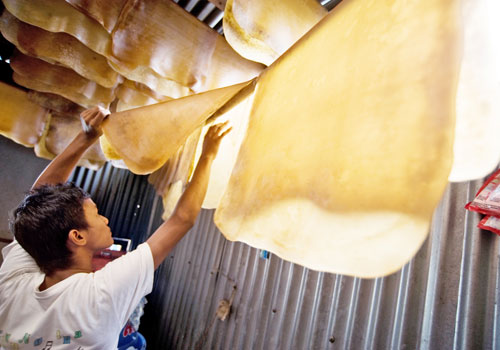The local rubber industry looks set to miss its export target this year as world prices have taken a tumble since the start of the decade.
 Rubber sheets dry in Mawlamyine. Photo: Kaung Htet
Rubber sheets dry in Mawlamyine. Photo: Kaung Htet
Some domestic producers say they are suspending production until prices rebound, as costs are above prices on some rubber plantations.
Benchmark Tokyo rubber and local prices have dropped by more than half since highs in early 2011, forcing belt-tightening in an industry once viewed as a potential cash cow for Myanmar.
The Myanmar Rubber Planters and Producers Association set a goal of 100,000 tonnes of exports this fiscal year, but with only 60,000 tonnes exported in 2014-15 to date, and one month left in the fiscal year, it seems certain that exports will fall well short.
“This year, I think we will fail to meet our target,” said association secretary general U Khine Myint.
Local producers say that with international prices poor, and local prices even lower because of weak quality, they are unable to make ends meet.
Ma Shan Ma, who owns 100 acres of rubber plantations in Yangon Region’s Phaung Gyi township, said she is not able to cover the cost of wages, calling the price decline a “fatal drop”.
Internationally, benchmark rubber sold for 220.4 yen (US$1.81) a kilogram in Tokyo yesterday, though had sold for about 500 yen in early 2010.
Much of Myanmar’s rubber industry is dependent on Thailand for areas such as processing and further export. Thailand, the world’s biggest rubber producer and exporter, also has a faltering rubber industry, with the government and industry groups attempting several initiatives to turn around the decline.
Prices decline for almost a year in line with oil prices, but began to pick up somewhat in December as poor weather cut supply from Indonesia and Malaysia, according to The Bangkok Post.
Closer to home, Ma Shan Ma has closed up shop.
She has been in the industry since 2006 and her plantations are ready to produce, but it is simply uneconomical to tap the trees and export the rubber.
“We can’t afford to produce, and have changed our business to other areas like manipulating the land we own,” she said. It costs between K2.5 and K3 million to plant rubber on one acre.
Trees need eight years to be able to produce, but until prices start to climb, Ma Shan Ma’s rubber fields will be idle.
Myanmar rubber exports hit a record of 93,000 tonnes in the 2010-11 fiscal year.
U Khine Myint said that while RSS3 standard rubber is fetching US$1800 a tonne in Bangkok, local prices are nearer to $1350 a tonne because of weaker quality.
Rubber trees produce year-round, with the exception of the height of rainy season and periods when the leaves fall from trees, said Daw Theingi Myint, a rubber researcher from Mawlamyine.
Unprocessed rubber harvest from the tree fetches K500 a pound (K1100 a kilogram), down from K1000 a pound in the past.
Rubber is a crucial crop for some areas of the country, covering for instance 500,000 acres in Mon State, she said.
U Khaing Myint said he is still holding on to hope for the industry.
Producers have not been taking steps to improve their crops, but simply changes like better seeds could more than triple average annual yields per acre to 1800 pounds.
“But they don’t have enough knowledge yet, they just keep on cultivating seeds which produce 500 pounds per acre,” he said.
For local producers, all eyes are on the possibility of a price bounce.
– mmtimes.com


























